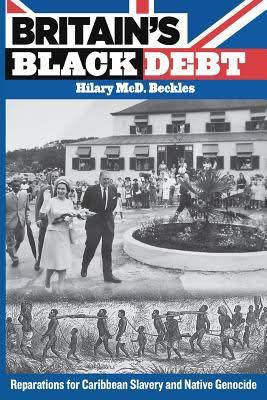In the fall of 2013, the Caribbean Community (CARICOM), an organization with 15 member states, sued the United Kingdom, France and the Netherlands for reparations, citing the three states’ participation in the genocide of native peoples, the slave trade and the institution of New World slavery. Filed with the International Court of Justice at The Hague in the Netherlands, the suit cast these historical injustices as crimes against humanity that required compensation. The lawsuit is the latest episode in an international reparations movement that began with the 1993 First Pan-African Congress on Reparations in Abuja, Nigeria, which set the foundations for the 2001 United Nations World Conference against Racism, Discrimination and Xenophobia in Durban, South Africa.1 Kingston: University of the West Indies Press, 2013.More Info →
Kingston: University of the West Indies Press, 2013.More Info →
CARICOM states and other regional institutions, such as the University of the West Indies, played a leading role in these early discussions and worked to make reparations a centerpiece of the discussions at Durban. Scheduled for August 2001 and soon to be overshadowed by the events of September 11, the conference faced challenges from Western powers and their client states, such as Nigeria and South Africa.2Ibid., 187. While African states under pressure from European states struck a more conciliatory note, African civil society organizations worked closely with Caribbean allies in support of stronger language around reparations. Weeks before the conference, the United States refused to participate citing, in part, the demand for an “International Compensatory scheme” for the slave trade and slavery.3Ibid., 185. Led by Britain, European states that participated in the conference rejected the description of the slave trade and slavery as crimes against humanity, arguing that while these practices were morally reprehensible, they were in fact legal under national and colonial laws of the time4Ibid., 189..
“At stake is a political claim that these crimes are deeply connected to contemporary global inequalities, that slavery and the slave trade enriched Europe and impoverished the Caribbean.”In Durban and the current lawsuit, the debate about whether slavery and the slave trade constitute crimes against humanity is not only or primarily a legal matter of what counts as a punishable crime under international law. Instead, at stake is a political claim that these crimes are deeply connected to contemporary global inequalities, that slavery and the slave trade enriched Europe and impoverished the Caribbean. As Tianna Paschel’s contribution to this series illustrates, the idea that poverty in the global South and wealth in the global North were historically co-constituted is not itself a novel argument. The analysis of what Andre Gunder Frank called the “development of underdevelopment” was a mainstay of anticolonial critique beginning in the early twentieth century. 5Andre Gunder Frank, “The Development of Underdevelopment,” Monthly Review (September 1966): 17–31.
Contemporary proponents of reparations acknowledge this long legacy, and in particular point to the central place of Eric Williams’s 1944 Capitalism and Slavery in their own demands.6Beckles, Britain’s Black Debt, 4, 100–102. Born in Trinidad in 1911, Williams received the island’s sole scholarship to attend Oxford University in 1932. He received his BA in history with first class honors and by 1938 had written a path-breaking dissertation on “The Economic Aspects of the Abolition of the West Indian Slave Trade and Slavery.” Six years later an expanded and revised version of his dissertation research was published as Capitalism and Slavery.7 The University of North Carolina Press, 1994.More Info → Williams’s book traced the ways slavery and the slave trade made British industrialization possible. However, his response never called for reparations. Understanding the Caribbean movement for reparations, thus, requires both situating it in the arguments Williams made about the centrality of slavery to European modernity, and recognizing how contemporary demands recast and resignify the implications of this argument.
The University of North Carolina Press, 1994.More Info → Williams’s book traced the ways slavery and the slave trade made British industrialization possible. However, his response never called for reparations. Understanding the Caribbean movement for reparations, thus, requires both situating it in the arguments Williams made about the centrality of slavery to European modernity, and recognizing how contemporary demands recast and resignify the implications of this argument.
Williams opens Capitalism and Slavery with attention to the historical conjuncture of its writing. Echoing his teacher and mentor C. L. R James, whose 1938 The Black Jacobins deeply influenced his own work, Williams writes: “Every age rewrites history, but particularly ours, which has been forced by events to reevaluate our conceptions of history and economic and political development.”8Williams, Capitalism and Slavery, ix. The events of his age included the rise of anticolonial nationalism spurred in the West Indies by a series of labor strikes and the Second World War, which once again revealed the instability and violence of an international order predicated on imperial hierarchy. For Williams, like many black Atlantic intellectuals of the 1930s and 1940s, the rewriting of history was central to efforts at diagnosing the political predicaments of the present and imagining postcolonial futures.9W. E. B. Du Bois’s Black Reconstruction (1935) and C. L. R. James’s The Black Jacobins: Toussaint L’Ouverture and the San Domingo Revolution (1938) similarly justify the rewriting of histories of emancipation with reference to the colonial landscape of the twentieth century, paying specific attention to the ways that these histories can inform anticolonial struggles. Williams’s rewriting of history was aimed at centering the contributions of the enslaved to the rise of industrialization. He argued that while much had been written about the history of British industrialization, “the world-wide and interrelated nature of the commerce” that produced this historic development had not been studied.10Williams, Capitalism and Slavery, ix. Seen in this light, the contribution of Capitalism and Slavery was “an economic study of the role of the Negro slavery and the slave trade in providing the capital which financed the Industrial Revolution in England and of mature industrial capitalism in destroying the slavery system”11Ibid..
Slavery, capitalism, and the problem of dependence
Williams’s argument is threefold. First, he argues that Britain’s involvement in the slave trade stimulated the domestic economy through the growth of the shipping industry and the production of goods to be sold in the triangular trade between Europe, Africa and the colonies of the New World. The plantations of the New World were the “great nurseries” of the shipping industry as ships were required to transport slaves to the West Indies, raw materials back to Britain and manufactured goods to the New World and Africa.12Ibid., 58. The shipping industry contributed to the rise of cities such as Bristol and Liverpool, transforming them into centers of the slave trade and key nodes in Britain’s industrialization. British products, in turn, crossed the Atlantic to be sold in Africa and the New World for a profit that continued to fuel the slave trade. Williams argued: “what the building of ships for the transport of slaves did for eighteenth century Liverpool, the manufacture of cotton goods for the purchase of slaves did for eighteenth century Manchester.”13Ibid., 68. Well before the rise of King Cotton in the American South, Manchester’s early growth was linked to African and West Indian markets14Ibid..
“The founders of banks in the eighteenth and early nineteenth century were intimately connected with plantations in the West Indies and the slave trade.”Second, the profits and capital generated form this lucrative trade supplied the necessary investments for British industry. Key banking institutions (including Barclays Bank) and insurance companies were born in towns such as Liverpool and Manchester. As Williams carefully details, the founders of banks in the eighteenth and early nineteenth century were intimately connected with plantations in the West Indies and the slave trade.15Ibid., 99-102. Similarly, the emerging insurance companies of this period set their sights on insuring slave ships and slaves.16Ibid., 104. As these financial institutions emerged out of the triangular trade, they would also help direct investment into new industries. For instance, capital from the West Indian trade and circulated through new banks helped finance James Watt’s steam engine17Ibid., 102. and the construction of railways connecting the emerging industrial towns, helping to create Britain’s modern domestic economy.18Ibid., 106. The steam engine and the railway set the stage for the high point of British industrialization with cotton at its center.19Ibid.
And, this leads to the final part of Williams’s argument about the relationship between capitalism and slavery. This maturing industrial economy very quickly came to see the colonial trade (of which slavery was a constituent component) that had produced it as an impediment to its further development. If Manchester owed its rise in the eighteenth century to the West Indian trade, in the early nineteenth century, the West Indies became a minor trading partner for this industrial town as the United State began to play a leading role in both supplying cotton and buying manufactured goods.20Ibid., 128. The shifting cotton industry was just one example of a broader transformation from a mercantile system to a global economy. According to Williams, “Britain’s mechanized might was making the whole world her footstool. She was clothing the world, exporting men and machines, and had become the world’s banker.”21Ibid., 131. From this newly gained global position, the colonies, and in particular the West Indies, were perceived as “millstones around Britain’s neck”22“Millstones around our neck” is Benjamin Disraeli’s phrase from 1852. But, as Williams shows, this sentiment was already in circulation prior to the abolition of slavery. that prevented free trade and were a net loss to the nation.23Williams, Capitalism and Slavery, 144.
There is an important irony in Williams’s account: While slavery and the slave trade had been constitutive of Britain’s modern economy, the new industrialists and capitalists that emerged from colonial trade would repudiate and reject the very conditions that had made their emergence possible. It was, according to Williams, a mature industrial economy that led to the abolition of the slave trade in 1807, emancipation in 1833, and an end to sugar preferences in 1846.24Ibid., 136. This aspect of Williams’s argument was aimed at deflating narratives that centered the humanitarianism of the abolitionist movement. In a caustic chapter titled, “The Saints and Slavery,” Williams critiqued the conservatism of key abolitionists, calling attention in particular to the their hypocritical boycott of West Indian sugar while never boycotting US cotton and to their limited vision of what emancipation should entail for the formerly enslaved.
“While Britain’s global rise had depended on the West Indian plantations, at the dawn of decolonization, the West Indies were dependent, underdeveloped, and played only a marginal role in global trade.”Equally important, however, were the ways that highlighting the economic logics of abolition helped to frame the political and economic predicaments of the West Indies in Williams’s own time. For Williams, the story of slavery’s rise and fall was also the story of how the West Indies went from playing a central role in the British economy to being a neglected and marginal part of the British Empire. Williams did not detail the implications of this marginalization in Capitalism and Slavery, but just as he put the final touches on his manuscript in 1943, he organized a conference to trace the ways that the history of slavery and emancipation was connected to the twentieth-century West Indian experience. Organized with his colleagues Rayford Logan and Franklin Fazier at Howard University, the conference focused on the “Economic Future of the Caribbean.” In his presentation, Williams traced how the history of colonization, the plantation, and enslavement had created a dependent economy in the West Indies. The Caribbean was an export economy that produced raw materials and had to import almost all its needs including food. Thus, conditions external to the region dictated the entire economy and, as a result, the West Indies were incredibly susceptible to fluctuations in global trade.25Eric Williams, “The Economic Development of the Caribbean up to the Present,” in The Economic Future of the Caribbean, eds. Franklin Frazier and Eric Williams (Washington DC: Howard University Press, 1944), 21. For instance, the rise of beet sugar in the nineteenth century quickly displaced West Indian sugar.26Ibid., 19. While Britain’s global rise had depended on the West Indian plantations, at the dawn of decolonization, the West Indies were dependent, underdeveloped, and played only a marginal role in global trade.
The answer to the problem of dependence for Williams was not a demand for reparations but the creation of a West Indian Federation. In his concluding remarks at the conference, he argued that “federation will make possible an economic development now impossible, and give the Caribbean area a bargaining power in the world which its isolated units do not now have.”27Ibid., 24. By uniting West Indian islands with similar predicaments in one political and economic structure, Williams and other Caribbean federalists hoped to redirect their economies towards producing the goods needed domestically and create a program for development and industrialization. Over time, the federation would transform dependence into self-sufficiency. For over a decade, Williams worked to establish a West Indian Federation, which was formed in 1958 with 10 Anglophone Caribbean states, but this project collapsed in 1962, ending Williams’s vision of a self-sufficient and independent Caribbean.
From dependence to criminal enrichment
While the federation failed, it laid the foundation for CARICOM, which is now at the forefront of the fight for reparations. The contemporary demand for reparatory justice recasts the problem of dependence that animated Eric Williams and many other anticolonial thinkers of the twentieth century. Writing at the dawn of decolonization, when the promise of the postcolonial state’s capacity to transform the legacies of colonialism was as yet untested, Williams placed his hopes in anticolonial nationalism and postcolonial institutions as engines of transformation. His vision was couched in the language of independence and autonomy, and his political imagination was structured by a commitment to and faith in the capacity of the state.
Half a century after formal independence, both nationalism and the postcolonial state have failed to fulfill the promises of development, democracy, and autonomy. Scholars might disagree about the causes and the nature of this failure, but there is no doubt that we live in an age that can no longer conceive of its aspirations for postcolonial futures in the terms and idioms that animated Williams. It is in this context that we must situate the contemporary demand for reparations.28David Scott, “Preface: Debt, Redress,” small axe 43 (March 2014): vii–x, ix. Reparations returns to Williams’s story of slavery’s centrality to the making of British (and European) modernity, but identifies the legacy of this history as an unpaid debt that is still owed. Decentering the problem of West Indian dependence, it instead highlights the question of Europe’s “criminal enrichment” and contends that the work of remaking the Caribbean is not possible without restitution.29Beckles, Britain’s Black Debt. In doing so, the demand for reparations “rewrites history” for our age, but does so by returning to the central insight of Capitalism and Slavery: that the history of the slave trade and slavery are not external to but constitutive of Europe.














